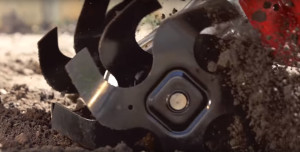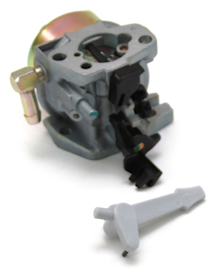Tiller common questions


These common questions about tillers are the ones our experts hear the most often from our customers. You might also find the help you need by checking the common symptoms and solutions for tillers. When you’re ready to make a repair, search your model number to find replacement parts. Sears PartsDirect has the part you need, no matter where you bought your tiller.
Why won't my tiller tines rotate?
A clevis pin couples the tines to the rotating tine shaft. If the shaft rotates but the tines don’t move, check whether the clevis pin is broken. If the clevis pin is sheared off, replace it. If the shaft isn’t rotating, you could have a defective transmission.
Why won’t the wheels move on my tiller?
If the tines rotate properly but the wheels won’t move, the tiller likely has an internal transmission failure.
Why won’t the wheels and tines rotate on my tiller?
Check the drive belt for excessive wear or damage. Check the control cables and the idler pulley. Adjust the drive control components if necessary. A defective transmission can also prevent the wheels and tines from rotating. Replace the transmission if it’s defective.
Why won’t my tiller cultivate properly?
Dull or bent tines can result in poor tilling. Replace the tines if they’re worn or damaged. A slipping drive belt can also cause this problem. Adjust the drive belt. If the drive belt is worn or damaged, replace it. Extremely hard ground is sometimes difficult to cultivate. Reduce your depth setting and use multiple passes to cultivate hard soil.
Why won’t my tiller engine start?
The engine needs fuel, spark and compression to start. Make sure the tank has fuel and that the fuel is fresh; stale fuel can become watery and won't ignite well. You could have a clogged carburetor if the fuel was stale. Check the spark plug. Verify that you have compression in the cylinder. These steps should help you determine the cause of your problem.
Can I use E85 fuel in my tiller?
Most riding lawn mower engines cannot use E85 fuel, which is 85% ethyl alcohol (ethanol) and 15% gasoline. Many riding lawn mowers can only use unleaded gasoline with up to 10% ethyl alcohol (E10). Check your owner’s manual for fuel specifications.
Where can I find engine parts for my tiller?
Engine parts are often listed separately from other tiller parts. Search the tiller parts list for the part number of the replacement engine, which is also the engine’s model number. You can also find the engine model number on the side or back of the engine. Enter the engine part/model number into the model number search field to view the individual component parts of the engine for your tiller.
Why does my engine die shortly after I start it?
Check the fuel level—low fuel in the gas tank could cause the engine to die.
A blocked vent on the gas tank cap could also cause the engine to die; loosen the gas cap so air can flow into the tank but don’t remove the gas cap completely. Then start the engine and see if it runs. If so, clean or replace the gas cap.
A clogged carburetor could also cause the engine to die. Rebuild or replace the carburetor if it’s gummed up.
Should I get a front-tine tiller or a rear-tine tiller?
Rear-tine tillers are better suited for large gardens more than 5000 sq. ft. in area because they usually till a wider path than a front-tine tiller. They’re more powerful, so are better for hard ground or previously untilled soil.
Front-tine tillers are better for smaller gardens less than 5000 sq. ft. or where space is tight. Front-tine tillers are lighter, easier to handle and more maneuverable.
How do I find the horsepower rating of a tiller?
Tiller engine manufacturers no longer rate the engines for horsepower. They provide engine cylinder displacement and torque ratings for comparison of the current tiller engines. An engine over 200cc of displacement is recommended for large gardens over 5000 sq. ft.
When should I till my garden?
You can till your garden in autumn, at the end of the gardening season or in the spring before the gardening season starts. Advantages of fall tilling are that the winter's freeze/thaw cycles will help break up larger soil clumps and you won't have to find time to till in spring, which for most people is the busiest time of the gardening season.
Whether you till in spring or fall, it's critical that you wait until the soil is dry enough, but not too dry. The soil is ready to be tilled when you can form the soil into a ball in your hand, and the soil ball breaks apart when you drop it. Tilling when the soil is too wet or too dry damages the soil structure.
Most common symptoms to help you fix your tillers
Choose a symptom to see related tiller repairs.
Main causes: clutch cable problems, faulty transmission…
Main causes: damaged tines, broken clevis pins, worn drive belt, faulty transmission, clutch cable problems, improper de…
Main causes: worn or broken drive belts, bad transmission, clutch cable problems…
Main causes: leaky engine head gasket, damaged sump gasket, damaged oil drain plug seal, loose or cracked fuel line, lea…
Main causes: broken shaft clevis pins, transmission failure…
Main causes: dirty carburetor, engine needs tune up, stale gas…
Main causes: carburetor failure, bad gasoline, dirty spark plug, broken recoil starter…
Most common repair guides to help fix your tillers
These step-by-step repair guides will help you safely fix what’s broken on your tiller.

How to replace a tiller recoil starter
The recoil starter spins the engine when you pull the starter rope, and the rope retracts when released. If the recoil s…
Effective articles & videos to help repair your tillers
Use the advice and tips in these articles and videos to get the most out of your tiller.

Learn about all the convenient features on our Sears PartsDirect website that make your parts purchases easier.…

Get answers to frequently asked questions about Sears and Sears PartsDirect.…

This chart will help you find the right carburetor for your Craftsman snowblower, tiller or log splitter.…